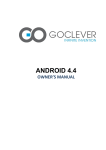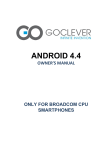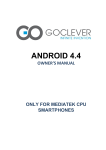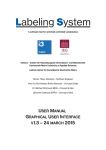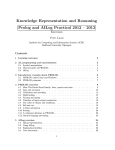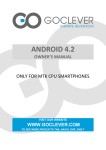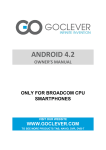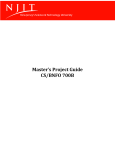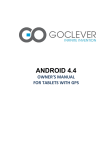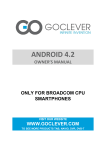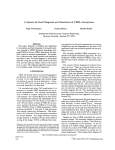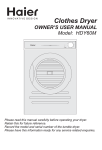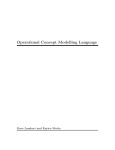Download Sigma User Manual
Transcript
Sigma Knowledge Engineering Environment
User Guide
version 2/15/2004
written by Adam Pease
adampease @ earthlink . net
Sigma Knowledge Engineering Environment Manual
License
This code and documentation is copyright Articulate Software (c) 2003.
Some portions copyright Teknowledge (c) 2003 and reused under the terms
of the GNU license. This software is released under the GNU Public
License http://www.gnu.org/copyleft/gpl.html.
Users of this code also consent, by use of this code, to credit
Articulate Software and Teknowledge in any writings, briefings,
publications, presentations, or other representations of any software
which incorporates, builds on, or uses this code. Please cite the
following article in any publication with references:
Pease, A., (2003). The Sigma Ontology Development Environment,
in Working Notes of the IJCAI-2003 Workshop on Ontology and Distributed Systems,
August 9, Acapulco, Mexico.
Note that the current release
for any mission-critical use.
Sigma comes with no warranty,
assume all responsibility for
Articulate Software blameless
of Sigma is “alpha” code, and not suitable
It is strictly a tool for research.
expressed or implied. By using Sigma, you
events it may result in, and agree to hold
for any adverse consequences.
Bug reports, fixed code and new implemented features are welcome however, and will be
shared with the Sigma user community.
Page 2
Sigma Knowledge Engineering Environment Manual
Table of Contents
License.................................................................................................................................2
Installation...........................................................................................................................4
User Guide...........................................................................................................................5
Reference Guide.................................................................................................................13
References..........................................................................................................................18
Appendix: Natural Language Format ...............................................................................19
Appendix: Test Formats.....................................................................................................20
Page 3
Sigma Knowledge Engineering Environment Manual
Installation
Follow the steps below to install Sigma
1. Install J2SE Java 2 SDK v1.4.1_05 [Windows (all languages, including English)
version] (downloaded from http://java.sun.com/j2se/1.4.1/download.html). Other
versions may work, but we don't guarrantee it.
2. Install Tomcat v4.0.4 (downloaded from http://archive.apache.org/dist/jakarta/tomcat4/archive/v4.0.4/bin/jakarta-tomcat-4.0.4.exe). Other versions may work, but we don't
guarrantee it.
3. Modify the startup script for Tomcat to use a large stack size. The Tomcat installation
should have added an item "Apache Tomcat 4.0" to your Start->Programs menu.
Beneath that menu should be an item "Start Tomcat". Right click on that menu item
and select "Properties". Then modify the "Target" field to add the command line
option "-Xmx300M". For example, depending on where you have installed the JDK,
the beginning of the command should be similar to:
C:\j2sdk1.4.0_01\bin\java.exe -jar -Xmx300M
4. Copy the KBs directory from the CD to your Tomcat directory
5. Copy the vampire directory onto your hard drive. The inference engine executable is
in \vampire\Vampire_VSWorkspace\vampire\Release\kif.exe
6. 6. Place <sigma.war> under your Tomcat installation at
C:\Program Files\Apache Tomcat 4.0\webapps
7. 7. Start up tomcat, and it should expand itself. Then go to
http://localhost:8080/sigma/KBs.jsp to get started. That page allows
you to create a knowledge base and select the KIF files that comprise it.
8. Edit C:\Program Files\Apache Tomcat 4.0\KBs\config.txt to have
the following line read:
<preference key="inferenceEngineDir"
value="C:\vampire\Vampire_VSWorkspace\vampire\Release"/>
or wherever you have placed the kif.exe file as a result of step 5 above. You may also
set this parameter by clicking "Preferences" from the Sigma home page.
Note that if you want to load a new version of Sigma, you must kill and restart Tomcat
as well as deleting the directory
C:\Program Files\Apache Tomcat 4.0\webapps\sigma
Page 4
Sigma Knowledge Engineering Environment Manual
User Guide
Sigma (Pease, 2003) is an environment for creating, testing, modifying and
inferencing on ontologies. In this guide, we will first run through a typical session of
using major Sigma functions, and then provide a reference to the remaining functions.
Note that Sigma does not contain functions for editing knowledge bases. Knowledge
bases in first order logic are similar to modern programming languages in complexity and
expressiveness, and the most suitable tool for editing is a powerful text editor, such as
one of the open source Emacs variants, or a commercial programming language editor
such as Visual SlickEdit. The color coding and formatting tools offered in such editors
can be very helpful. Sigma serves the same purpose as a modern IDE, supporting
structured examination, project management, and debugging.
The first screen one sees is a login screen (Figure 1)
Figure 1. Login screen
In its present version, Sigma has only the most rudimentary login functionality with one
hard-wired password that allows access to all Sigma functions. If that password is not
chosen, only read-only operations are allowed.
Page 5
Sigma Knowledge Engineering Environment Manual
Figure 2. Knowledge Bases screen
The next screen (Figure 2) is a listing of all the knowledge bases loaded, the
operations allowed on those knowledge bases, and a form for creating a new knowledge
base. The standard installation of Sigma comes with the Suggested Upper Merged
Ontology (Niles & Pease, 2001) pre-loaded, so you should see a screen similar to that in
Figure 3.
Figure 3. Manifest
Page 6
Sigma Knowledge Engineering Environment Manual
Sigma organizes ontologies in knowledge bases which are collections of files selected
by the user. Each knowledge base consists of several constituents which are files in
Knowledge Interchange Format (KIF) (Genesereth, 1991). A particular simplified dialect
of KIF is used (Pease, 2004). Each knowledge base has a manifest which shows the files
it contains.
The most fundamental component of Sigma is a statement browser, which presents
logical statements in which a given term appears. Clicking “Browse” on the Knowledge
Bases screen brings you to a browser page for the selected knowledge base. The initial
page just lists some statistics for the knowledge base, and provides space to type in a
term from the knowledge base
Figure 4. Initial term browser screen
In the browser screen in Figure 4, the user has typed the term Walking. The browser
screen in Figure 5 shows all the statements in the knowledge base in which the term
Walking appears. Clicking on a hyperlinked term in a statement brings the user to the
browser page for that statement. For example, clicking on the term Running causes the
browser to show all statements in which the term Running appears. The browser also
shows, in the blue-grey center column, which KIF file the statement comes from, and at
what line number it appears on the file. In the right hand column, an English paraphrase
is shown. The paraphrases are generated automatically based on a set of format
statements. On the Manifest page about, we can se the file engligh_format.kif has been
loaded. That file contains language paraphrasing statements for English. In the term
browser screens, one can see at the top right a menu for “Language:”. That menu is
constructed automatically based on the presence of language formatting statements in the
knowledge base. Format files are available for SUMO in Italian, German and Hindi
(among others).
Page 7
Sigma Knowledge Engineering Environment Manual
Figure 5. Term browser page for the SUMO term "Walking"
If the user types a word into the KB term box that is not found, Sigma responds with a
set of terms which are closest, alphabetically, to the given term, as shown in Figure 6.
Page 8
Sigma Knowledge Engineering Environment Manual
Figure 6. Term neighbors
By typing a word in the “English Word:” box, one can get a list of all English word
senses in the WordNet lexicon that match, and their mappings to terms in SUMO (Niles
& Pease, 2003). For example, entering the word buffalo results in Figure 7
Note that the first time the English Term function is used that there will be a delay as
all the entire WordNet lexicon and SUMO mappings are loaded.
Page 9
Sigma Knowledge Engineering Environment Manual
Figure 7. English word listing
Another important functionality in Sigma is for performing logical inference. From the
Knowledge Bases screen, click on the Ask/Tell link. For a trivial inference, we can ask
for a subclass of the class Entity. We get back a very simple proof as shown in Figure
10, that the class Abstract is a subclass of Entity. Sigma is integrated with the Vampire
(Riazanov & Voronkov, 2002) theorem prover.
While a full discussion of the proofs resulting from a resolution theorem prover are
beyond the scope of this manual, we can point out a few items from the proof. Each step
in the proof is numbered, and each step also has a justification for how it was derived.
This is either a list of numbers, for example, line 4 shows that it was derived from step 3.
Currently, no further justification about the inference rule applied is provided, although
in this case, one can see that 4 is derived from 3 simply by renaming the variable. Steps
can also be taken directly from the knowledge base, which is denoted by “[KB]”, or from
the query itself. The proof method employed is proof by contradiction, where the query
is negated, and the system tries to find a contradiction that results. So, we see the label
Page 10
Sigma Knowledge Engineering Environment Manual
“[Negated Query]”.
Figure 8. Sigma proof
The inference engine can be controlled by limiting the number of answers it is directed to
find, as well as by providing a time cutoff. On a large, interconnected knowledge base
there are so many possible search paths that the inference engine would frequently
continue to search indefinitely if such cutoffs are not provided.
One can also assert an individual formula to the knowledge base by entering a KIF
statement, and clicking the “tell” button. That new formula then becomes accessble for
inference and browsing. If the user has not previously done a “tell” to the current
knowledge base, the system created a file called “_userAssertions.kif”, and add the
formula, as well as any subsequent formulas, to that file. The file will be loaded
automatically when Sigma is restarted, and it can also be deleted from the manifast like
any constituent if desired.
Note that first order inference is computationally expensive and expected results may
not be achieved, even if they logically follow from the knowledge base. Also, Vampire
has no notion of what it means to return a common-sense answer, just a logically correct
one, so general axioms in SUMO can occasionally give rise to answers which although
logically true, may not be useful or expected. A final caution on inference is that
although SUMO assumes a sorted logic, Vampire is currently unsorted, and therefore
axioms can occasionally be employed in ways that are inconsistent with the argument
types defined for SUMO relations, resulting in spurious answers. We hope to remedy
this in a future version.
Page 11
Sigma Knowledge Engineering Environment Manual
Sigma has a simple caching function that may improve many inferences, since
reasoning about subclass relationships often necessary. Sigma can compute the transitive
closure of subclasses statements and assert them directly, so that Vampire does not need
to apply the subclass reasoning axiom in SUMO during inference, but can find the
ground statement directly. For example, if we ask whether Human is a subclass of
Object, Vampire will have to apply the same axioms several times. It may in fact find
another search path and get stuck, since it doesn't know what common-sense answer we
are looking for. By asserting directly that Human is a subclass of Object, we can shortcircut a number of spurious inference paths, and get better and faster results. Caching is
turned on from the Preferences “[Prefs}” page.
Figure 9. Preferences page
This page also allows the user to set the directory in which the inference engine
executable is found, the address of the server which is running Sigma, the name of the
KB containing SUMO, directory in which inference tests are found, whether
automatically cached statements should be displayed in the browser, and whether the
Controlled English to Logic Translation (Pease & Murray, 2003) system should be
loaded at startup. This component is experimental, and not generally included in the
Sigma distribution.
Page 12
Sigma Knowledge Engineering Environment Manual
Reference Guide
The reference guide is organized according to the web/jsp pages available to the user in
Sigma.
Figure 10. Pages and navigation in Sigma
login
This page allows the user to type in a login and password. In the current version of
Sigma, an administrative password grants full access to Sigma functions, and all other
user name and password combinations result in the availability of strictly read-only
functions.
KBs
This page lists all the knowledge bases loaded into Sigma. Each knowledge base can be
examined or manipulated through a set of functions, which are
• Manifest – takes the user to the Manifest page, which shows all the files which
comprise the knowledge base
• Browse – takes the user to the Browse page, where all the statements for a given term
are presented, and the user may also search for the alphabetical neighbors of a term,
and for English words and their links to SUMO.
• Graph – takes the user to the Graph page which presents a graph of terms for a given
relation
• Diagnostics – takes the user to the Diag page which provides diagnostics on the
knowledge base
• Inference Tests – takes the user to the InferenceTestSuite page where files in a
selected directory, which specify inference tests, are executed and tallied
• CELT Tests - takes the user to the InferenceTestSuite page where files in a selected
directory, which specify CELT tests, are executed and tallied
• Ask/Tell – takes the user to the Ask/Tell page where one can make KIF or restricted
Page 13
Sigma Knowledge Engineering Environment Manual
•
English statements and questions to the knowledge base
Remove – delete the given knowledge base
WordNet
This page shows the WordNet synsets for the word and part of speech that he or she has
selected. Each synset shows the WordNet definition, and the SUMO term or terms that
are linked to that synset. Clicking on a hyperlinked SUMO term takes the user to the
term browser page for that term. The user can also type in another word and select a
different part of speech if desired. Sigma performs some simple processing of words that
allows a word to be found even if the user types a plural or past tense, since WordNet
stores only the root grammatical forms of words.
Browse
The browse page is where the ontologist is likely to spend the most time. When no term
is selected, three metrics are displayed. “Total terms” are the number of names defined
in the knowledge base. They may be classes or instances. Note that variables do not
count. “Total Axioms” are the number of statements in the knowledge base. Note that
these are user-authored statements and this measure is arguably imprecise, since different
users could alternately code (=> A (and B C)) as one statement and (=> A B) (=> B C) as
two statements, even though they are logically equivalent. “Total Rules” is also
somewhat of an approximation. Sigma counts occurances of “=>” and “<=>”. Since (=>
A B) is equivalent to (or (not A) B), logically equivalent knowledge bases could have
different metrics. Note also that the number of rules is a subset of the number of axioms.
The browse page has a number of controls. “KB term” allows the user to search for a
term in the knowledge base, and display all statements which include that term. If the
term is not found, the terms which are closest, alphabetically, are displayed. When
statements are displayed, they are hyperlinked, so that when the user clicks on a term, he
is automatically taken to the term browser page for the term.
The “English Word” area functions as described in the WordNet page description in
this section.
There are links on this page to the “home” knowledge base listing page, the Ask/Tell
page, Graph page and Pref(erences) page.
There are two menus at the top right of the page. One menu simply selects the
knowledge base. This is an alternative to selecting “Browse” from a knowledge base on
the KBs page, since one can select the knowledge base of interest directly, without
having to return to that page. The second menu is the “language” menu.
Sigma is capable of loading KIF files which specify natural language formatting
templates. These templates allow Sigma to paraphrase logical statements in a natural
language. The formatting is quite simplistic, but can give some assistence to users who
are either not comfortable in logic, or not comfortable in the human language which an
ontology has been written. The definition language is defined in the Appendix: Natural
Language Format.
The user can load several natural language format files. The selection in the language
menu tells Sigma in which language to format statements. The natural language
paraphrases appear in the right hand column of the statement listing.
Page 14
Sigma Knowledge Engineering Environment Manual
The center column of the browser page shows the name and line number of the file
that contains the statement.
Manifest
The manifest page contains a listing of all the files that comprise the selected knowledge
base. Full path names are provided. Next to each file is a link to remove the file. Below
the list are controls that allow a new file to be added to the knowledge base.
Properties
This page allows the user to set the directory in which the inference engine executable
is found. This can also be set directly in the config.txt file as specified in the installation
instructions.
The user can set address of the server which is running Sigma. This allows hyperlinks
to function properly when the user is working with a Sigma installation that is on a
server, rather than on his desktop.
The user should set the name of the KB containing SUMO. This allows the
hyperlinks on the WordNet page to function properly.
The user can set the directory in which inference tests are found. The format for these
tests is given in the Appendix: Inference Test Format.
The user can set caching should be performed, and whether automatically cached
statements should be displayed in the browser. Because caching results in the transitive
closure of all subclass statements this can result in a large amount of information which,
although helpful to inference engine performance, is not helpful when shown in the
browser.
The user can set whether the Controlled English to Logic Translation (Pease &
Murray, 2003) system should be loaded at startup. Starting this component can take
several minutes, so it's often helpful to turn this off when work in CELT is not being
routinely performed. Also, since this component is experimental, it is not included in the
general Sigma distribution and must be turned off in that case.
Graph
This page allows the user to get a hierarchical view of terms and relations in a knowledge
base. Most typically, the user selects the subclass relation in order to see a portion of a
class/subclass tree. The user selects a particular term and the number of “levels” above
and below that term to display. Only a text view is supported at this time. The user can
select a different binary relation, such as “subrelation” for example, in order to see a
hierarchy of predicates. This page also includes KB and language menus as described in
the reference for the Browse page. Levels in the hierarchy are indicated by degree of
indenting.
AskTell
This page supports asserting new statements to the knowledge base, and posing logical
queries to the knowledge base. If the CELT system has been loaded, all non-KIF
statements are assumed to be natural language statements, and are passed to CELT.
CELT queries are terminated with a question mark, just like an English question. All
Page 15
Sigma Knowledge Engineering Environment Manual
other sentences are assumed to be statements. This page includes menus for the
knowledge base, and the language in which natural language paraphrases are presented
(see the description of the Browse page for more detail on these controls).
Pressing, the “tell” button results in the statement being asserted to
KB_userAssertions.kif, where “KB” is the name of the current knowledge base. If there
is a syntax error in the statement however, it is not asserted, and an error message will
appear.
Pressing the “ask” button results in a query being posed to the inference engine.The
inference engine can be controlled by limiting the number of answers it is directed to
find, as well as by providing a time cutoff. On a large, interconnected knowledge base
there are so many possible search paths that the inference engine would frequently
continue to search indefinitely if such cutoffs are not provided.
While a full discussion of the proofs resulting from a resolution theorem prover are
beyond the scope of this manual, we can point out a few items from the proof. Each step
in the proof is numbered, and each step also has a justification for how it was derived.
This is either a list of numbers, for example, line 4 shows that it was derived from step 3.
Currently, no further justification about the inference rule applied is provided, although
in this case, one can see that 4 is derived from 3 simply by renaming the variable. Steps
can also be taken directly from the knowledge base, which is denoted by “[KB]”, or from
the query itself. The proof method employed is proof by contradiction, where the query
is negated, and the system tries to find a contradiction that results. So, we see the label
“[Negated Query]”.
InferenceTestSuite
This page will run and show the results of inference tests in the directory indicated in the
Preferences. Note that all tests will be run before results are shown. This can take a long
time if there are many tests. If no time limit is given for a particular test, a default of 30
seconds is used. It will be helpful to view the Tomcat window for messages showing
how the tests are progressing. When the tests are complete, a list will be shown with
links to each test source, its proof, if found, whether the test was successful as compared
to the expected answer, and how long the test took. A total is provided for time and
correctness. Appendix: Test Formats described the format of test files. This same page
also runs CELT tests, if the user clicks on the “CELT Test” link from the KBs page.
CELT test results are shown in three columns with the English input first, then the
expected logical form, the actual logical form, and whether the test failed or succeeded.
CELT test format is described in the Appendix: Test Formats.
Diag
Three basic tests are run over the entire knowledge base when this page is selected. They
are:
•
Terms without documentation – whether each term has a 'documentation' relation
defined.
•
Terms without parent – whether each term has an 'instance' or 'subclass' relation
defined for it
•
Terms without a root at Entity – whether each term ultimately is an instance or
Page 16
Sigma Knowledge Engineering Environment Manual
subclass of Entity, which is the root term in SUMO
Many other tests would be valuable, but these simple tests do indicate some common
problems.
Page 17
Sigma Knowledge Engineering Environment Manual
References
Genesereth, M., (1991). “Knowledge Interchange Format'', In Proceedings of the Second
International Conference on the Principles of Knowledge Representation and
Reasoning, Allen, J., Fikes, R., Sandewall, E. (eds), Morgan Kaufman Publishers, pp
238-249.
Niles, I., & Pease, A., (2001), Toward a Standard Upper Ontology, in Proceedings of the
2nd International Conference on Formal Ontology in Information Systems (FOIS2001), Chris Welty and Barry Smith, eds.
Niles, I., and Pease, A., (2003). Linking Lexicons and Ontologies: Mapping WordNet to
the Suggested Upper Merged Ontology, Proceedings of the IEEE International
Conference on Information and Knowledge Engineering. (IKE 2003), Las Vegas,
Nevada, June 23-26, 2003.
Pease, A., (2003). The Sigma Ontology Development Environment, in Working Notes of
the IJCAI-2003 Workshop on Ontology and Distributed Systems, August 9, Acapulco,
Mexico.
Pease, A., (2004). Standard Upper Ontology Knowledge Interchange Format. Language
manual, unpublished.
Pease, A., and Murray, W., (2003). An English to Logic Translator for Ontology-based
Knowledge Representation Languages. In Proceedings of the 2003 IEEE International
Conference on Natural Language Processing and Knowledge Engineering, Beijing,
China, pp 777-783.
Riazanov, A., & Voronkov, A., (2002). The Design and Implementation of Vampire, AI
Communications, Volume 15. Numbers 2-3.
Acknowledgements
Many thanks to Michal Sevcenko for defining the natural language format language, and
to the Air Force and ARDA for their support for Sigma development.
Page 18
Sigma Knowledge Engineering Environment Manual
Appendix: Natural Language Format
The 'format' predicate associates a concept (either relation or a function with a string. The
format predicate takes three arguments: the name or abbreviation of a natural language,
the relation name and the format string. When there is a need to visualise certain concept
in natural language, the associated string is used. The string contains a natural language
description of the concept and special tags which are interpreted with the browser.
The description of these tags follows:
• &%token - specifies a token that will be made into a hypertext link to concept
being visualized
• %1, %2, ... - this tag will be substituted with a natural language representation of
the concept's respective argument
• %n{text} will be replaced either with empty string, if a predicate is being rendered
as positive, or 'text' otherwise; the %n tag can be used as a shortcut for %n{not}
• %p{text} replaced with 'text' for positive rendering and with an empty string for
negative rendering
• %*{range}[delim] will be replaced with a list of natural-language representation
of a subset of arguments; range specifies which arguments will be included - it is a
comma separated list of numbers or ranges; for example, range '1-4,6' denotes first,
second, third, fourth and sixth argument; the delim parameter specifies the
delimiter which will be used to separate representations of arguments; both {range}
and [delim] may be ommited - range defaults to all arguments, and delim defaults
to a single space
• %% will be replaced with a single percent character
The 'termFormat' predicate relates a term to a natural language presentation of that term.
It takes three arguments, the name or abbreviation of a natural language, the term name
and the format string
Page 19
Sigma Knowledge Engineering Environment Manual
Appendix: Test Formats
Inference test files are legal KIF files. They must end with the extension “.tq”. There are
several special purpose predicates that are supported. 'note' is a unary predicate that takes
a term which will be the identifier for the test. 'query' is a unary predicate that has a KIF
query as its only argument. 'answer' is a unary predicate whose argument may be either
'yes', 'no' or a list pair of variable name and value. 'time' is a unary predicate whose
argument specifies the number of seconds the system should wait for an answer.
There may also be a single CELT test file in the same test directory. It must be
named celtTest.txt. It must be legal KIF. It contains pairs of statements. The first
special unary predicate is 'sentence' which takes a string containing a CELT sentence as
its argument. The second special unary predicate is 'answer' which takes a KIF formula
as its argument. The output of CELT is compared against the answer formula to
determine the success or failure of the test.
Page 20




















